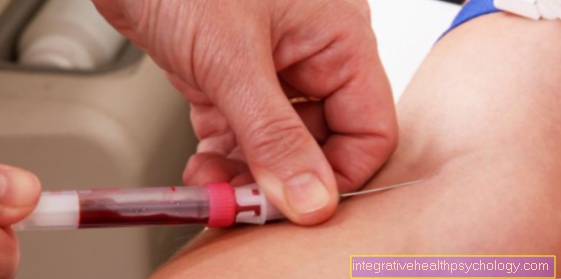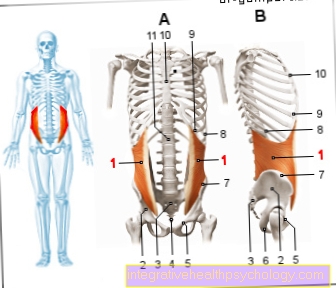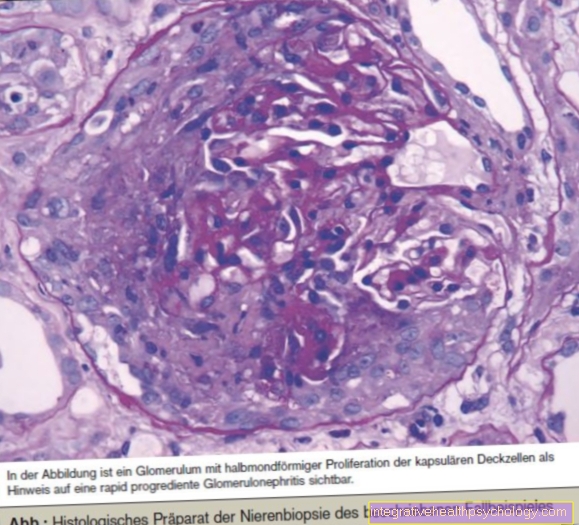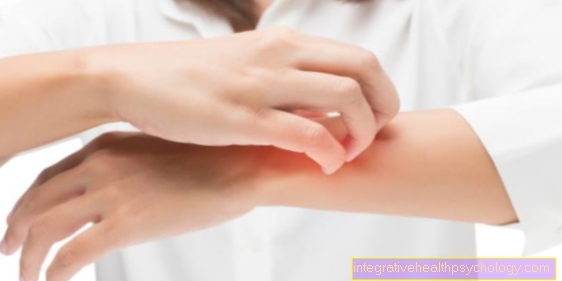Fingertip pain
definition
Pain in the fingertip refers to painful sensations in the area above the finger joint furthest away from the body. These can also occur in the nail area. The quality of the pain can be very variable, depending on its cause. For example, stabbing, tingling, pressing, tapping or boring pain can occur. In addition, the sensation in the fingertip or the mobility of the finger can be impaired, especially if finger joints are also affected.
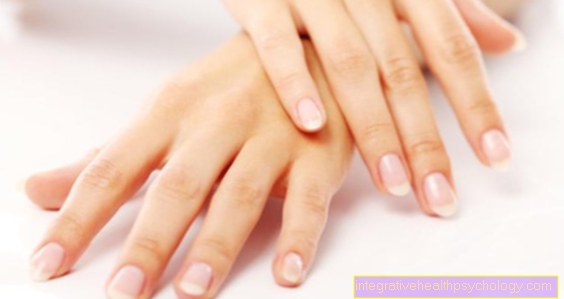
Causes of fingertip pain
The pain may be due to trauma, such as a cut in the fingertip. Then there is usually acute pain. If the wound becomes infected or there are problems healing, the affected area may continue to hurt. The nail bed can also be inflamed and therefore painful, among other things. After excessive strain or unfamiliar work, the fingertip can also hurt, for example after playing a stringed instrument for a long time, after gardening or repetitive work with the affected finger in general. Joint pain emanating from the wrist joint can also radiate into the fingertip. This could be the case with joint inflammation (arthritis, including rheumatism) or with joint wear and tear (arthrosis). Tendovaginitis can also show up as pain in the fingertip.
Find out more about the following articles:
- Finger osteoarthritis
- Dislocation of the finger joint
- Broken finger
- Torn ligament on the finger
Carpal tunnel syndrome
Carpal tunnel syndrome is a neurological disease that can take various courses and is associated with numerous symptoms and disorders of sensitivity. Carpal tunnel syndrome is based on compression of the so-called "median nerve", one of the main nerves of the hand. This pulls numerous muscles and tendons, as well as blood vessels from the forearm to the palm. Above the wrist, these structures run through a narrow area bounded by ligaments, the carpal tunnel. This can narrow and compress the nerve for a number of reasons. Manual work, increased muscle development and hand injuries with scarring can lead to tightness. Pregnancy, kidney dysfunction, alcohol abuse, hypothyroidism and diabetes can also trigger carpal tunnel syndrome.
The clinical picture usually begins with abnormal sensations such as tingling, numbness and pain in individual fingers that occur at night. Later, the frequency and intensity of symptoms may increase. Paralysis of the hand muscles can also be a result. The carpal tunnel syndrome should be treated as soon as possible, before permanent damage to the median nerve occurs. In the case of persistent and recurring complaints, the focus is on surgical therapy, in which the ligaments that form the carpal tunnel are cut.
Polyneuropathy
Polyneuropathy is an umbrella term for various diseases of the nervous system that have different triggers and courses. What they all have in common is that nerve fibers are damaged in their course and several different nerves are always affected. The best known and most common form occurs symmetrically on areas remote from the trunk, for example the toes and fingers. This leads to sensory disorders such as tingling, numbness and pain. The disease slowly progresses symmetrically towards the trunk of the body. One speaks of a “stocking-shaped border”. The most common causes of polyneuropathy and the associated pain at the fingertip are diabetes mellitus, alcohol abuse, pregnancies, hereditary neuropathies, metal and drug poisoning, as well as bacterial and viral diseases. Treatment consists primarily of treating and controlling the underlying disease.
diagnosis
In general, your family doctor is the right person to contact if you have pain in the fingertip, as it is unclear where the pain is coming from. This will include the circumstances, the time course and accompanying symptoms in the diagnosis. Perhaps the cause arises, such as B. a cut, even without further diagnosis, so that treatment can be started. If the fingertip is also inflamed or the nail is also affected, a dermatologist may be involved. A smear or a microbiological sample of the affected area can also help to narrow down the possible pathogen and thus to resort to the right therapy. If there is suspicion that the bone is also affected in the event of an inflammation or injury, an X-ray of the affected hand is taken. A small blood count including inflammation values may also be useful. If Raynaud's disease is suspected, a cold provocation test or a fist test to assess the blood flow can be performed. If the end of the finger is particularly affected, gout, rheumatic disease, joint wear and tear or any other impairment should be excluded.
You can find out more about the topic here: Inflammation on the finger
Appointment with a hand specialist?
I would be happy to advise you!
Who am I?
My name is dr. Nicolas Gumpert. I am a specialist in orthopedics and the founder of .
Various television programs and print media report regularly about my work. On HR television you can see me every 6 weeks live on "Hallo Hessen".
But now enough is indicated ;-)
In order to be able to treat successfully in orthopedics, a thorough examination, diagnosis and a medical history are required.
In our very economic world in particular, there is too little time to thoroughly grasp the complex diseases of orthopedics and thus initiate targeted treatment.
I don't want to join the ranks of "quick knife pullers".
The aim of any treatment is treatment without surgery.
Which therapy achieves the best results in the long term can only be determined after looking at all of the information (Examination, X-ray, ultrasound, MRI, etc.) be assessed.
You can find me at:
- Lumedis - orthopedics
Kaiserstrasse 14
60311 Frankfurt am Main
Directly to the online appointment arrangement
Unfortunately, appointments can only be made with private health insurers. I ask for understanding!
Further information about myself can be found at Lumedis - Dr. Nicolas Gumpert
Therapy for fingertip pain
Treatment for fingertip pain depends on the cause of the pain. If there is an injury, it will be treated appropriately. Depending on the depth, it (and any damaged structures) must be sewn or stapled and connected, or a plaster is enough. Protecting the hand, elevating and cooling as well as taking painkillers such as ibuprofen or paracetamol can also help. If there is inflammation, pus must be emptied, if present, and the area carefully cleaned and disinfected. Antibiotic treatment (e.g. tablets, depending on the pathogen) or therapy against (nail) fungal diseases may be necessary. Raynaud's syndrome can be treated with calcium antagonists such as nifedipine, and cold and wet conditions should generally be avoided. Diseases of the joint are also to be treated depending on the cause with gout medication, rheumatism medication or otherwise. In the case of wear (arthrosis), stiffening of the end joint should be considered.
Learn more about: gout and arthrosis
Duration
The duration of treatment and pain also depends on the cause. After an injury and its treatment, the pain usually subsides quickly, and inflammatory pain should also improve after a few days with correct treatment. In chronic diseases, the pain can improve acutely, but then recur after a symptom-free phase. If the pain does not improve after a short time or even gets worse, a doctor should (again) be consulted soon.
Concomitant symptoms
In addition, signs of inflammation such as overheating, redness, swelling and impaired function of the fingertip can occur. This is particularly the case with inflammation of the joints, nail beds, nerves or tendon sheaths. Bleeding will also occur in the above cuts. Alternatively, the fingertip can be pale and cold. This could be a sign of Raynaud's disease (white finger disease), which may experience tingling or sharp pain. This is based on an episode-wise circulatory disorder of the fingers. Numbness or hypersensitivity can also occur. The finger is generally numb if the blood circulation or the transmission of sensory impressions via the responsible nerves is disturbed. In the case of hypersensitivity, nerve irritation or a disease of the nervous system in general can be the cause.
Read more on the topic:
- Pain under the fingernail
- Inflammation of the nail bed on the finger
- Nerve inflammation
- Burning in the fingers
Cut on the fingertip
A cut on the finger is one of the most common injuries. This can happen quickly when cutting in the kitchen or at work. Such a wound usually bleeds profusely and leads to wound pain. The intensity of bleeding and pain depend on the structures that were also injured: the wound can bleed in a spurting and pulsating manner if an artery has been injured. If the wound is bleeding profusely, it should be treated, i.e. sewn or stapled, by a doctor as soon as possible (within a maximum of 6 hours). Here it is also important to hold up the affected hand. Usually, cuts to the fingertip are harmless and can be treated with a skin plaster after impurities have been excluded.
Tension pain on the fingertip
A splinter in the fingertip may cause particular pain when the affected area is pressed. Depending on the position of the fingers at which pressure pain occurs, this can also indicate a cause in the neighboring joint. Inflammation in the area of the fingertip, for example in the area of the nail, can also be very painful on pressure.
Nail pain on the fingertip
A possible explanation for this is an ingrown nail or an inflammatory change in the area of the nail. The smallest injuries can lead to a purulent inflammation due to germ migration. If deeper structures such as tendons are also affected, the inflammation can spread to the hand and arm (phlegmon). To prevent this, the affected (pus) area is usually punctured and rinsed. Antibiotic therapy is also given. An ingrown nail is a risk factor for nail inflammation and can itself cause tenderness.
Find out more about:
- Torn fingernail
- Pus in / on the finger
- Pus under the skin
- Chewed fingernail
Swelling with pain at the fingertip
Additional swelling of the fingertip can occur either as part of an inflammatory reaction, an allergic reaction or impaired lymphatic drainage. If the cause is inflammatory, other accompanying symptoms (reddening, impaired function, overheating) are usually observed. Here you have to pay closer attention to the "main point", possibly to a wound or pus leak. You should also check your fingertip for an insect bite, which may have triggered a localized allergic reaction. It can also be helpful to think about what substances you came into contact with with your fingertip. It is also important whether the rest of the fingers, possibly even the whole hand or arm, are also swollen - this would indicate a drainage disorder.
Alternatively, you might be interested in this article: Joint swelling on the finger
Pain in the fingertip when it is cold
If pain in the fingertips regularly occurs in a cold environment, this indicates Raynaud's syndrome, in which the finger (or fingers) initially pale after exposure to the cold or stress, then turns blue due to lack of oxygen, and turns red when rewarmed.
This can take a few minutes to an hour.The reason for this can be spasms (occlusions) of the supplying vessels ("primary" or "idiopathic") or the syndrome can occur after taking certain medications or in the context of other blood disorders (increased viscosity of the blood) ("secondary") . This can be better narrowed down with blood tests and clinical tests.
Pain in the fingertip from playing the guitar
Beginners in particular, whose fingers are not yet used to constantly pressing down the strings, can feel pain after playing the guitar for a long time. This is not uncommon and should subside over time due to a grown corneal layer on the fingertip. There are a few home remedies to make guitar playing more bearable, such as: For example, dipping your fingers in apple cider vinegar for 30 seconds before and after playing, or using creams containing benzocaine, a local anesthetic. In general, it helps in this situation to take regular breaks and to practice shorter, but more often - and of course patience!
Further information
- Tendon tear on the finger
- Carpal tunnel syndrome
- Treatment of finger osteoarthritis
- Causes of finger osteoarthritis
- Torn ligament on the finger
- Pain under the fingernail
- Burning in the fingers





